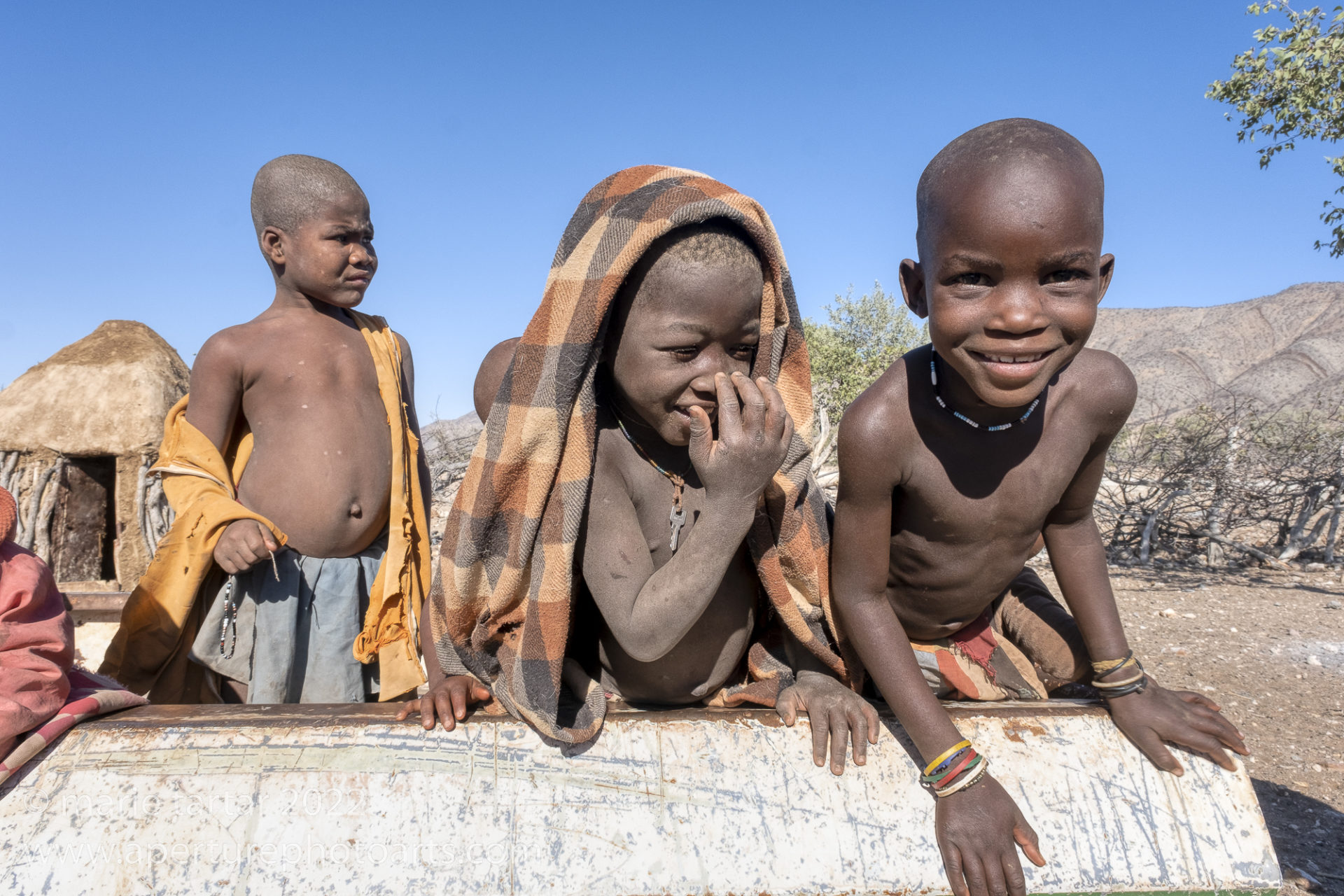
Tuesday June 7, 2022
After our “vacation within a vacation” at Walvis Bay, with too numerous to count flamingos and pelicans for subjects, we did another serious about-face in emphasis today, heading north for a stretch of the Skeleton Coast before turning inland on a trajectory aimed at Palmwag, our homebase for two nights as we headed into the land of the Himba people.
The Skeleton Coast is a vast and formidable desert stretching north along the Atlantic Coast towards the border with Angola. The cold Benguela Current contributes to the rough seas, dense fog and strong currents for which this coast is known. This coast is so remote that shipwrecked sailors would have little hope of rescue or survival if they were unfortunate enough to be waylaid on this stretch of coastline. The skeletons of the name refer to remains from whaling operations and seal hunts, as well as derelict shipwrecks and the occasional stranded human. The northern half of the national park of the same name can only be accessed by plane.
Although on our morning traverse we did not witness the famous fog, we did experience some of the ferocious forces which work on this stretch. Stopping to photograph the 2008 wreck of the Zeila, it was so windy it was difficult to obtain a motion free shot, even on a tripod, of this stationary carcass.

Wreck of the Zeila, Namibia: Obtaining a motion-free shot on a tripod is usually easy, but not in the intense winds we encountered on this stretch of the Skeleton Coast! This is one of multiple tries (4 seconds long trying to blur the Atlantic coast waters. This fishing trawler was sold as scrap metal and was being towed to India when it broke loose after leaving Walvis Bay. It can be seen off-shore between Swakopmund and Henties Bay, dotted with birds.
Along the desolate coast are scattered settlements of holiday homes and fishing camps, as well as other wrecks, including a terrestrial one, a downed and defunct oil rig.
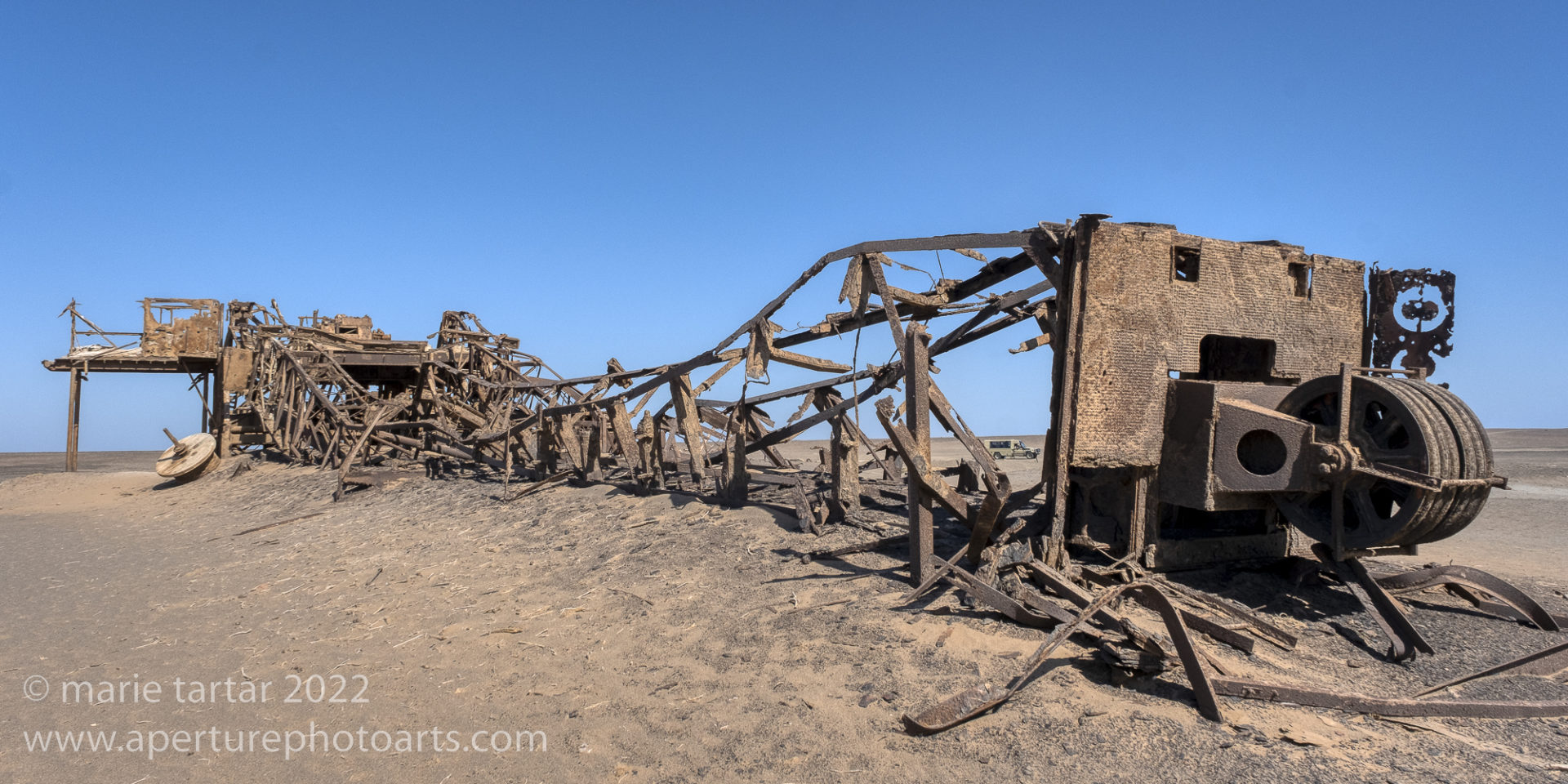
More abandoned dreams: former diamond miners Ben du Preez and Jack Scott drilled a kilometer down into the sands of this Namibian Skeleton Coast stretch thinking they would find oil, but found only anthracite.
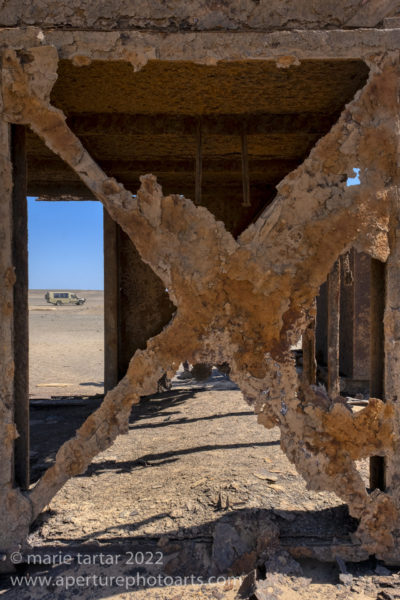
Wind, fog and salt have reduced this Namibian Skeleton Coast downed oil rig into a heavily textured and sculptural rust pile.
The endless expanses of flat sand barrens gradually gave way to low red hills covered with basalt volcanic rocks, dating back to an eruption 600 million years ago. We kept our eyes peeled for desert adapted animals en route.
Asked what he looks for to spot a rhinoceros, Forster replied “a massive termite mound which is moving”. Although we didn’t have any luck spotting desert elephants or rhinos, we did see giraffes in golden light and a trio of bustards.
Abundant rain earlier in the year produced abundant and golden grasses. The eroded forms and scrubby vegetation reminded me of the desert southwest of the US.
Our accommodations for tonight and the next are the charming Palmwag Lodge. Their open air dining pavilion is pandemic-safe perfect. Martin laughed when he heard me pronounce Palm-wag phonetically (in my defense, I had never heard anyone say it). The correct pronunciation sounds like it has 3 syllables, more like pal-la-veh?
Wednesday June 7, 2022
We spent the entire day traveling towards, visiting with and returning from a two-pronged visit with a tribe of Himba people. I was surprised to hear Martin say that they did not know we were coming, so it was possible we might arrive to find them not at home. They are a semi-nomadic people, with a largely intact and preserved culture revolving around livestock herding, namely sheep and goats. They measure their wealth in cattle. There are some 50,000 Himba (also known as OvaHimba) living in northern Namibia and southern Angola around the Kunene River. They do have semi-permanent home bases where they cultivate rain-feed crops such as millet and maize, which are staples of their diet.
It was over an hour’s drive and probably closer to two before we arrived to a circle of round dung-covered wood huts and a corral inside an enclosure.
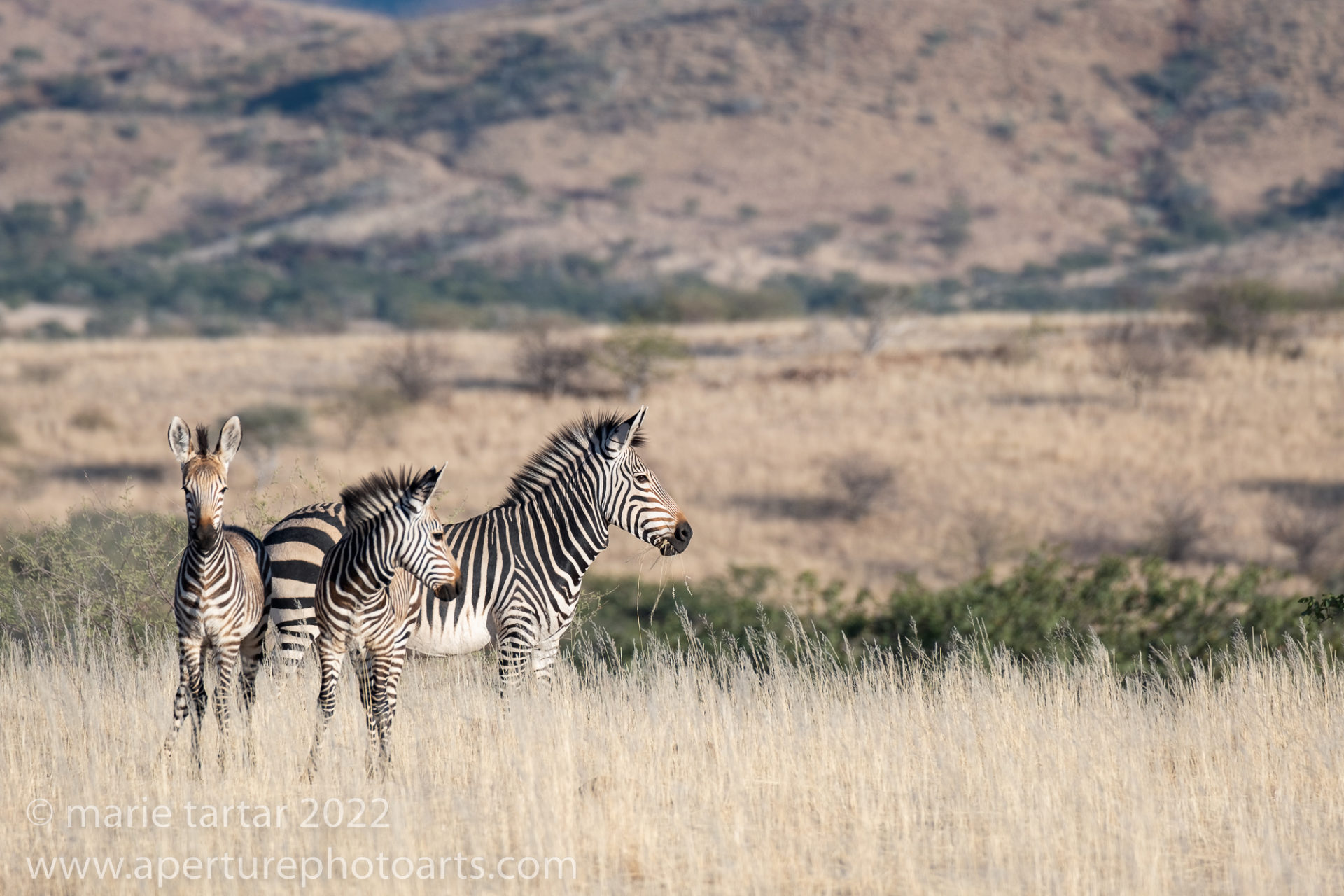
A trio of Hartmann’s mountain zebras in northern Namibia, near Palmwag. Their stripes do not extend across the belly.
En route, we had wildlife sightings to prolong our journey and photograph: kudu (a large antelope), springbok (a small antelope), Hartmann’s mountain zebras.
Since the pandemic hiatus, this was Martin’s first trip to Namibia in 3 years and Forster’s first trip guiding in 2 years. It also seemed we were likely the first visitors these Himba people had seen in quite a while, as Martin’s predictions that they might well quickly tire of our portrait sessions did not come to pass. He even had to prod them to set out their handicrafts for sale later in the afternoon.
After a warning not to walk in front of the okuruwo, the sacred ancestral fire, which faces the opening to the chief’s hut, we entered the compound and were quickly swarmed by curious and eager children.

This young Himba girl, Tjiringa, wears her two braids forward signifying her pre-pubertal status. Her reddish skin tone suggests she has coated her skin with otjize. Girls begin this practice when they are old enough to care for themselves.
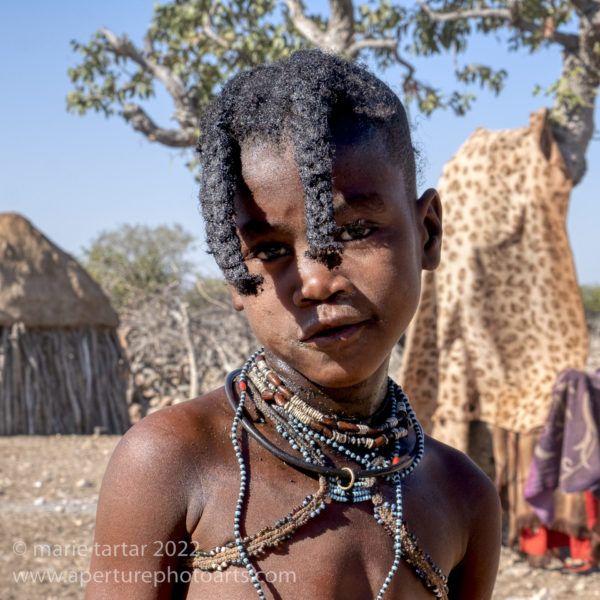
Tjiringa: a young Himba girl with characteristic hairstyle signifying her age, sex and pre-pubertal (pre-marriage age, which may be as young as 10 years old!) status.
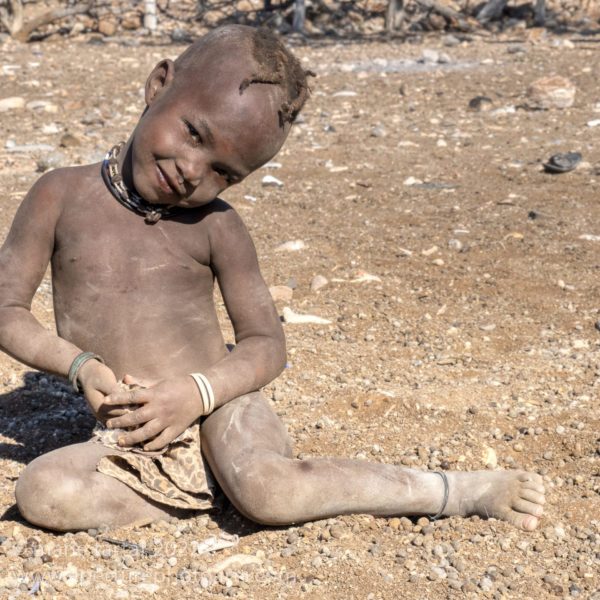
Young Himba girl in typical dress of loincloth, with characteristic braided hairstyle and jewelry. The ground is probably 50% goat poop.
Martin organized a series of portrait sessions with several of the women, who were resplendent in layers of jewelry, with their skin and hair glistening with a reddish paste of butterfat and ocher, otjize.

Uatondouje, a young married woman, quickly became our favorite “model” in this Himba village. The erembe headress she wears signifies her status as a woman married at least a year and/or a woman who has had a child. The cone shell in her necklace (ohumba) is a symbol of fertility.
Otjize is an aesthetic choice, as well as being said to serve as sunscreen and insect protection and mixed with the aromatic resin of omuzumba, is a desert alternative to washing with water. It seemed surprisingly effective, as hard as it was to imagine living in a desert without bathing or smelling. The women use smoked herbs to cleanse portions or all of their bodies by inducing sweating.
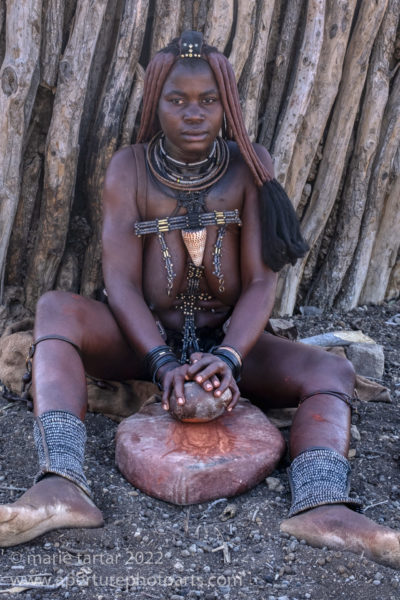
Himba woman demonstrates how ocher is ground with stones to create the rich red color of the otjize paste with which the women coat their bodies and hair.

These Himba boys in the bed of a derelict pick-up truck (minus the truck) kept us entertained with their antics.
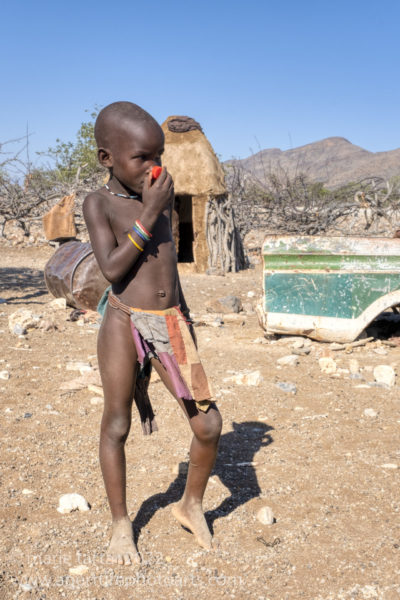
Young Himba boy playing around with a red bottle cap; I doubt he has ever heard of Rudolph the Red-nosed Reindeer.
The children kept us entertained when not actively photographing the women in the hut designated as “the studio”. The huts are circular, without windows, with the only light coming in through a single opening.
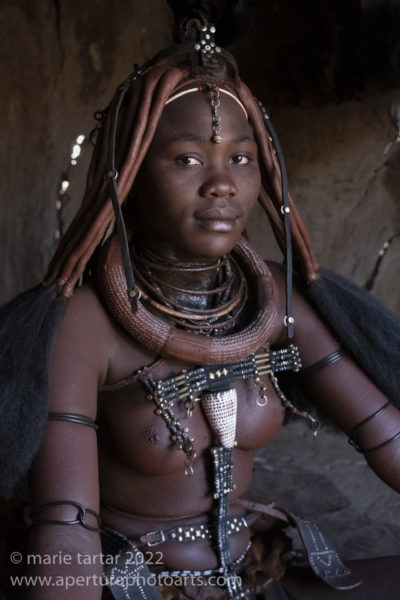
Uatondouje inside the “studio” hut of the Himba village we visited. Her hair is braided and coated with otjize, with the strands finished at the bottom with pom-poms of goat hair.
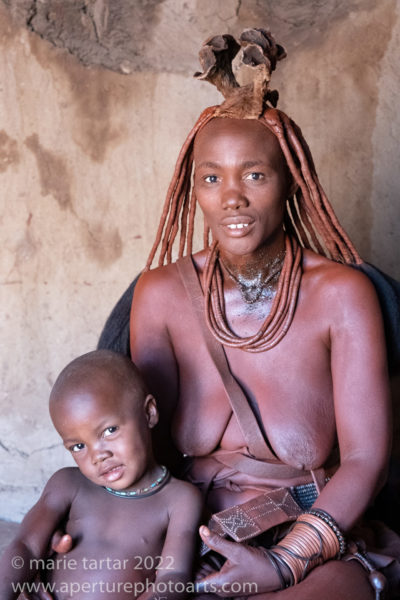
Himba mother and son, northern Namibia, in a typical village hut. Her carved leather headdress reflects her status as a mother.
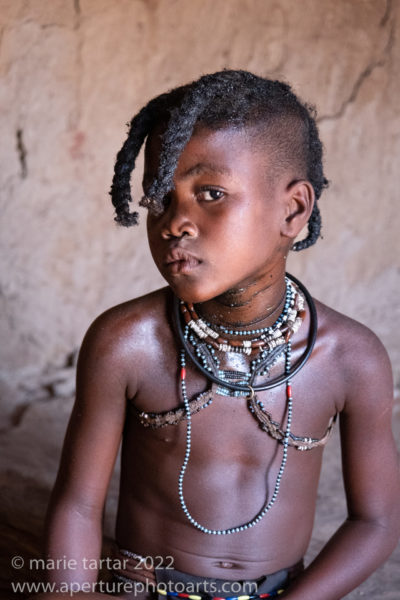
Tjiringa’s skin, coated with otjize, glowed in the soft light of a hut interior. Himba village, northern Namibia. The two forward braids signify her pre-pubertal status.
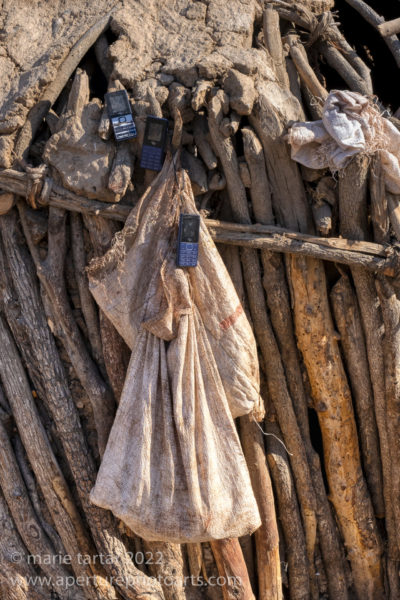
Evidently, the Himba are not completely without some modern amenities, judging by this collection of cellphones hanging outside a hut.
After a delightful morning interacting with the children and photographing the women, Forster drove us mid-day to a fortress turned hotel Fort Sesfontein Lodge where we hung out with a praying mantis that determinedly climbed our arms and necks without fear.

This praying mantis entertained us, here exploring Jon’s neck, while we relaxed mid-day at a fortress turned hotel for lunch, Fort Sesfontein , north of Palmwag, Namibia.
Meanwhile, Forster was off procuring thank you gifts for the village, specifically requested bags of flour, sugar and other staples.

Goats are central to the Himba way of life. The huts are simple, circular wood constructions, which the women maintain. Interwoven branches form a corral for the goats beyond.
When the harsh light of midday was past us, we returned to the village where more photographic fun was in store for us. Goat herding is intrinsic to the Himba way of life and Martin had asked the women to demonstrate, which they did, repeatedly, raising great clouds of dust.
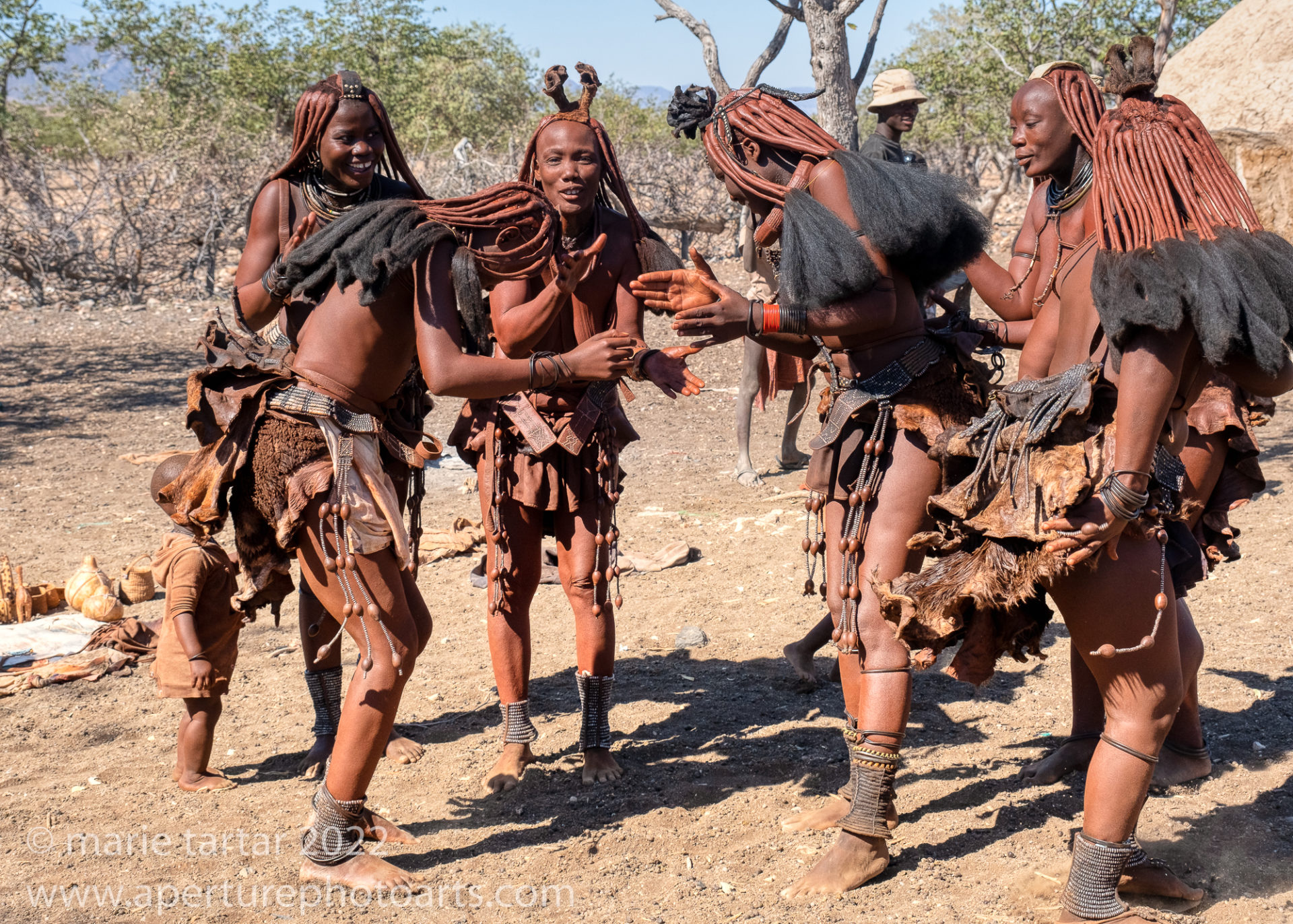
After the goat herding demonstrations, the Himba women danced for us in the afternoon. The little boy (left) kept wanting to get in on it and went on to have a little melt-down. Notice how the ankles are covered-they are considered by the Himba as the most sacred part of a woman’s body.
With regard to division of labor, like women the world round, it seems the Himba women and girls do the heavy lifting, tending the children, gardening, collecting firewood and water, maintaining their huts, cooking and serving meals as well as milking cows and goats and making jewelry and handicrafts for sale. The men’s responsibilities primarily lie in the care of livestock, which may take them away from the village for extended periods of time.The women certainly bore the primary responsibility for entertaining the guests, which they did most obligingly.
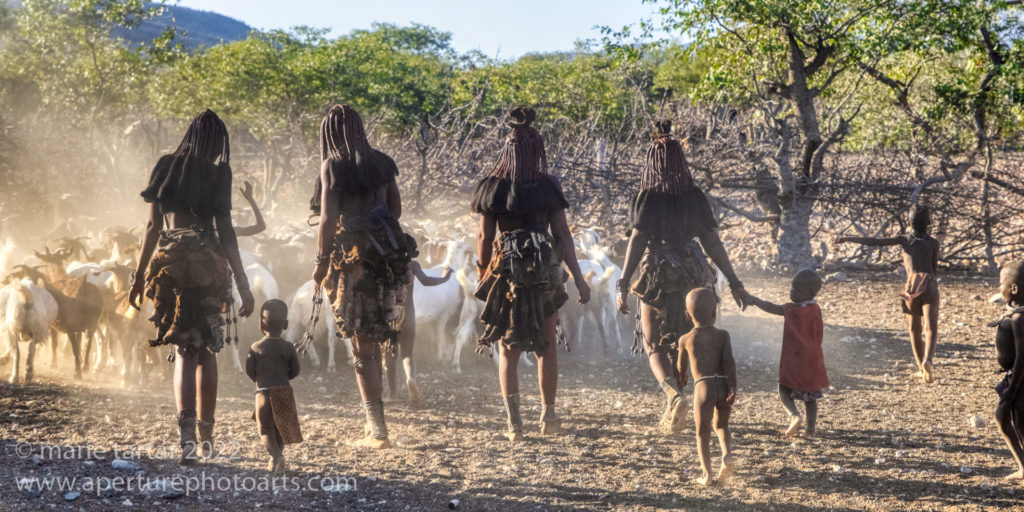
Himba women with children, driving home goats, at the end of a long and most enjoyable and informative day for us.
Culturally, this day spent with the Himba, was certainly a highlight of this trip, which had so many high points it’d be tough to pick just one. From Palmwag, we were onto the wildlife devoted segment of the trip, 4 days of safari in Etosha National Park.
To be continued…eventually…
-Marie
For more of Namibia’s startling visual richness, check out earlier installments:
Namibia: May-June 2022 (Part 1: Quiver Tree Forest and Giant’s Playground)


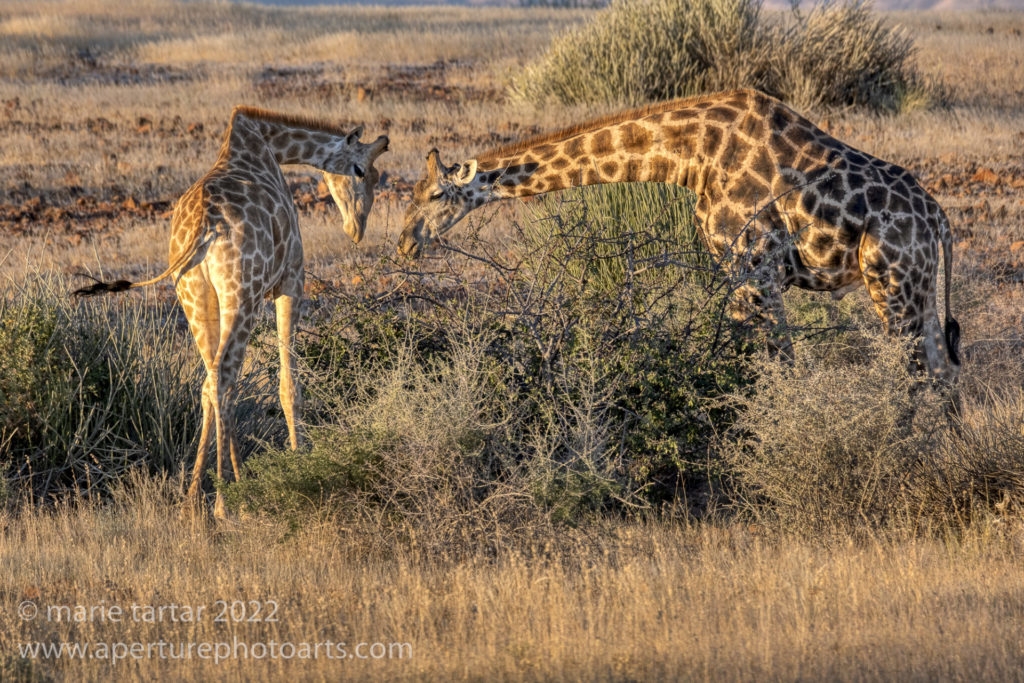
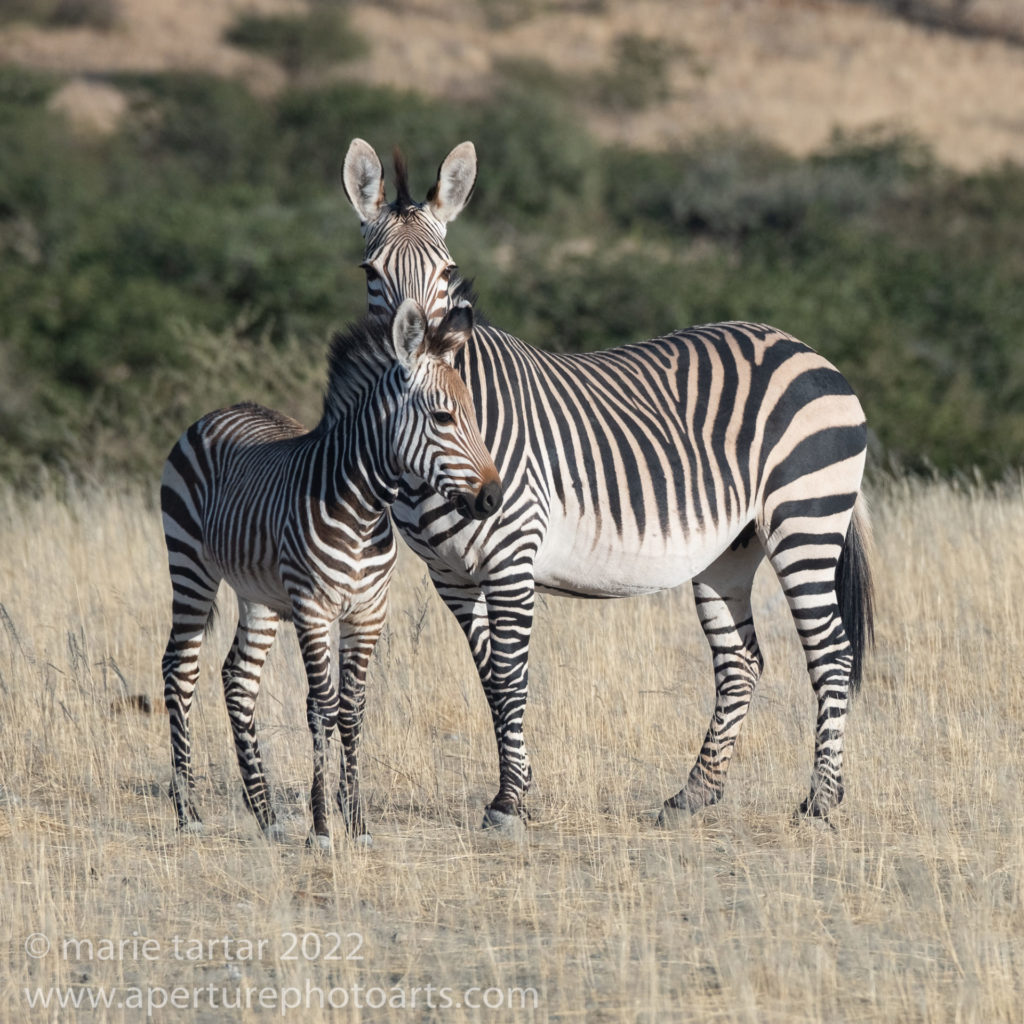

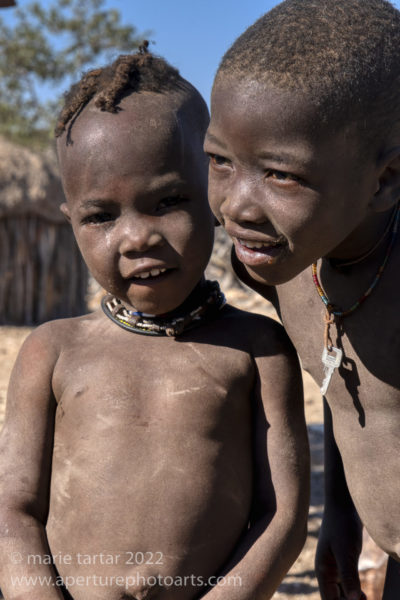
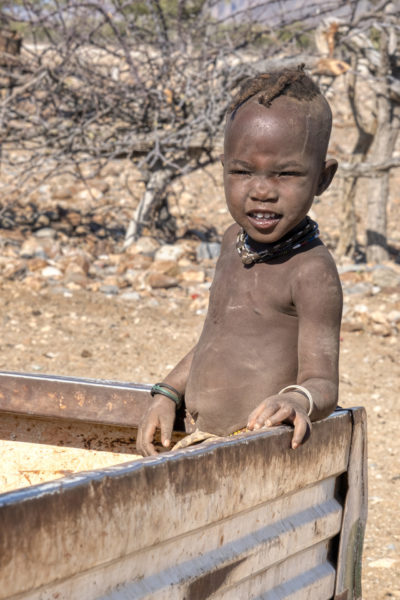
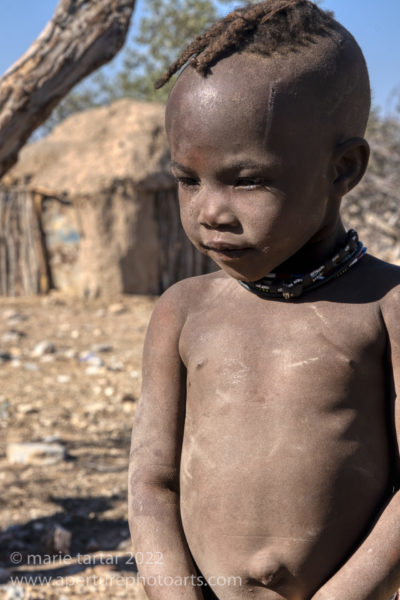
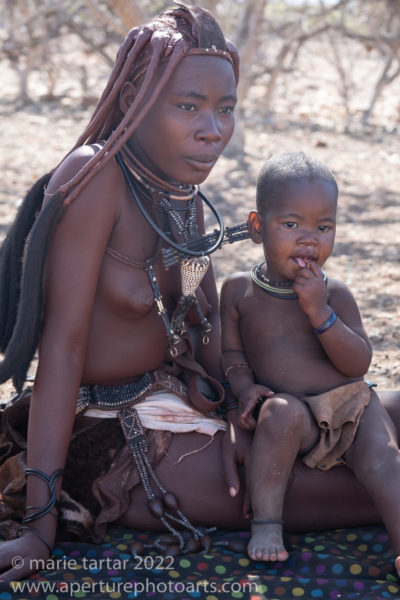
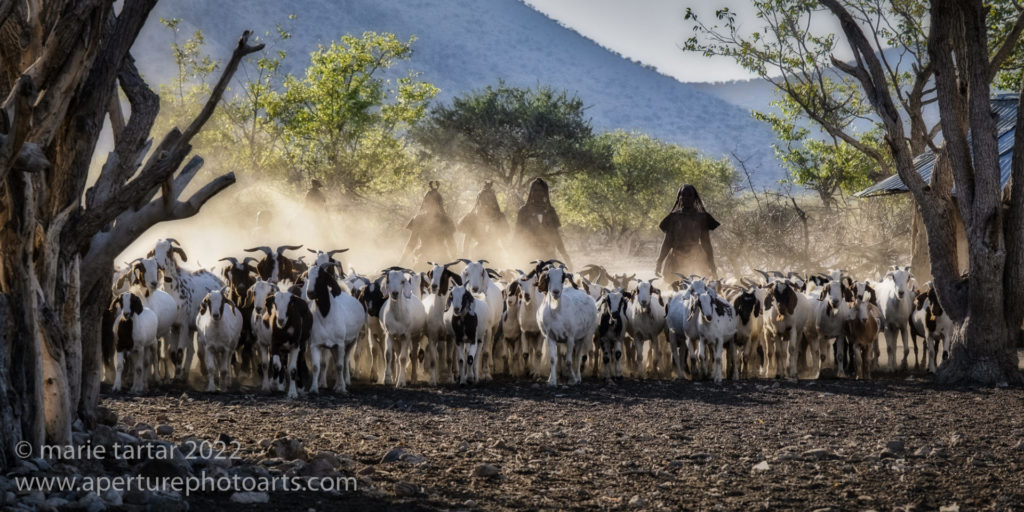
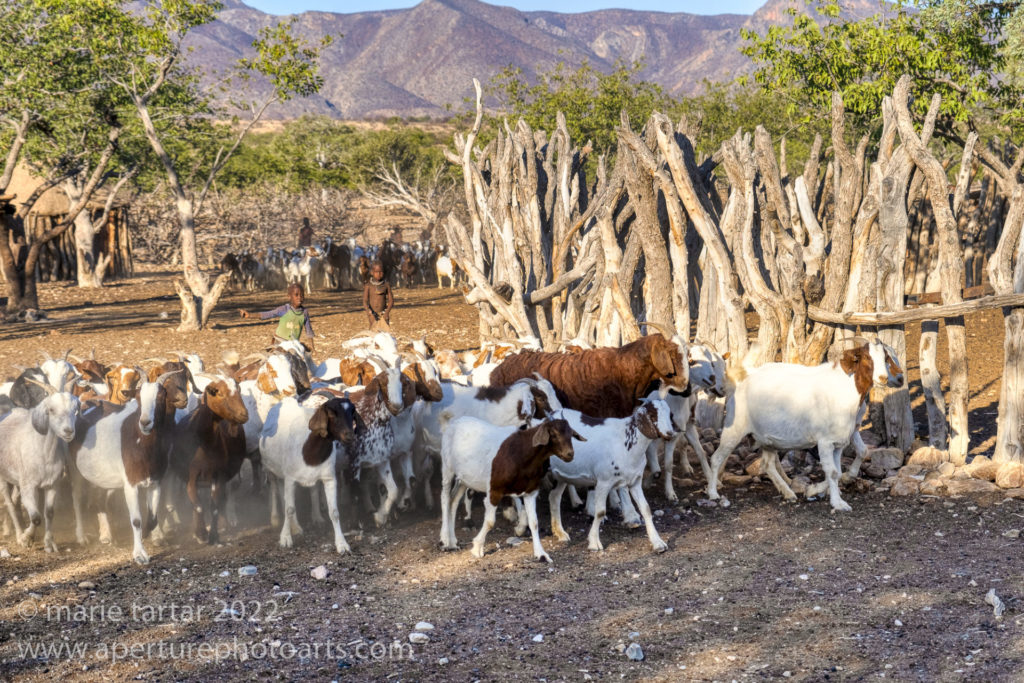
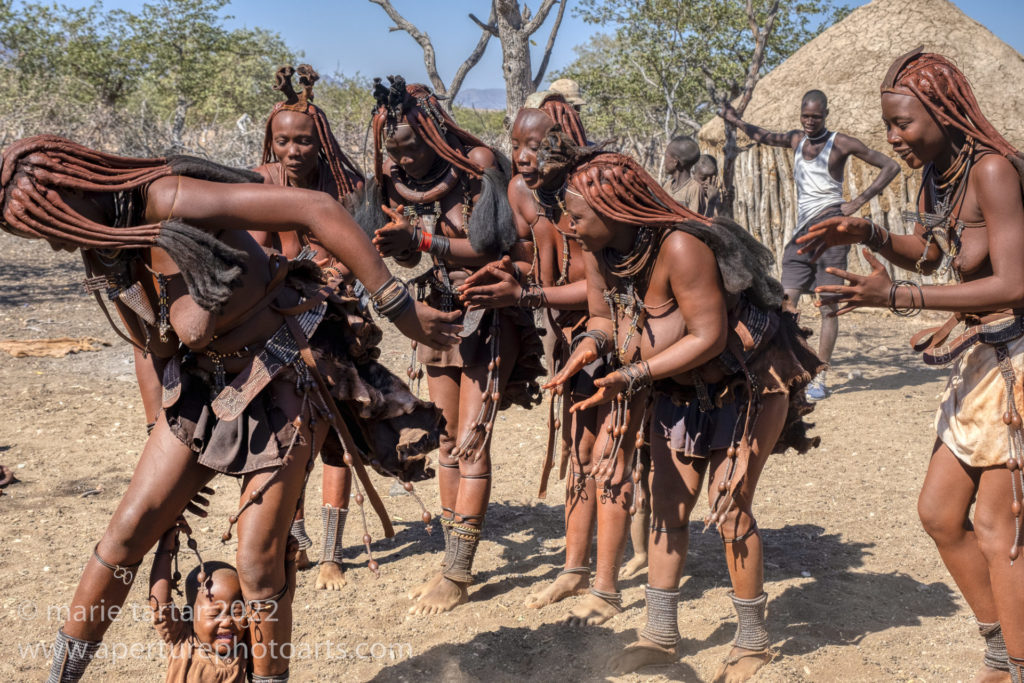

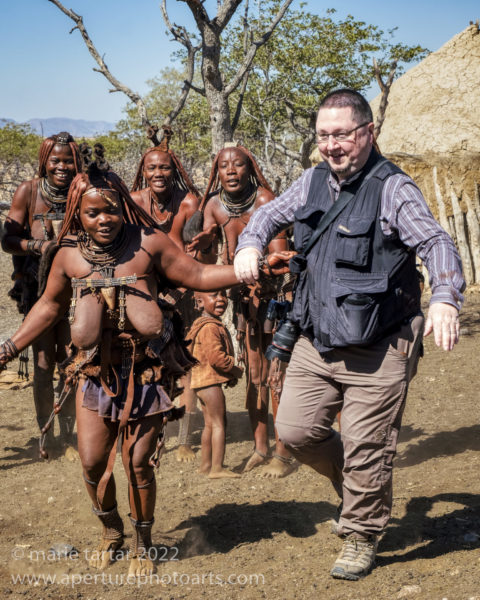

Such good memories, Marie!
You have described the day at the Himba well.
Keep well there.
Jan